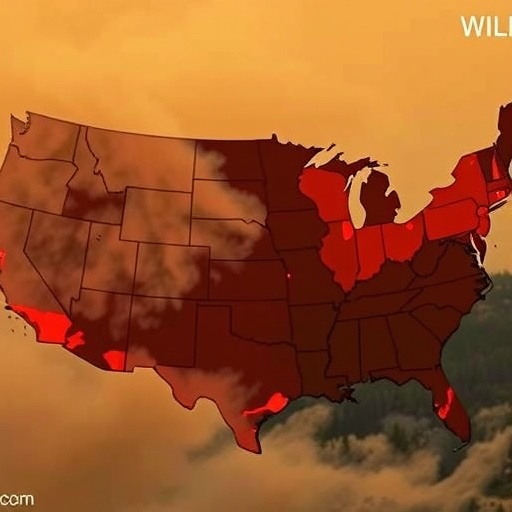In recent decades, wildfire frequency and intensity across the United States have escalated markedly, a trend scientists have closely linked to the escalating impacts of climate change. While the visible devastation of wildfires—the destruction of homes, forests, and infrastructure—is widely recognized, the insidious toll of wildfire smoke on public health remains less apparent yet profoundly consequential. Groundbreaking new research published in Nature provides a comprehensive quantification of the mortality burden attributed to wildfire smoke fine particulate matter (PM₂.₅) under projected future climate scenarios, revealing a stark outlook for public health in a warming world.
Wildfires generate massive plumes of smoke laden with fine particulate matter, predominantly PM₂.₅, microscopic particles capable of penetrating deep into human lungs and entering the bloodstream. Exposure to these particles is known to exacerbate respiratory and cardiovascular conditions and increase premature mortality. However, accurately modeling how changing climate variables translate into wildfire activity, subsequent smoke dispersion, and finally, health outcomes has remained a formidable challenge. The causal chain is complex and involves multifaceted interactions between temperature, humidity, vegetation, and human factors, compounded by regional variability in smoke exposure and population susceptibility.
The new study overcomes these challenges by employing an innovative ensemble approach that integrates statistical and machine learning models. This ensemble links historical climate data to wildfire smoke PM₂.₅ concentrations across the United States, improving the robustness of projections. By correlating these exposures with detailed mortality records encompassing all-cause deaths nationwide, the researchers empirically establish refined smoke PM₂.₅-mortality relationships. This dual-pronged methodology bridges the critical gap between environmental modeling and epidemiological evidence, enabling more precise forecasting of mortality attributable to wildfire smoke under future warming scenarios.
Central to the study’s findings is the projection that, under a high-emission climate pathway (SSP3-7.0), wildfire smoke PM₂.₅ could cause approximately 71,420 excess deaths per year across the US by 2050. This represents a dramatic 73% increase relative to the 2011–2020 baseline average of annual excess deaths linked to smoke exposure. Such an escalation signals that wildfire smoke is poised to become an escalating public health crisis unless aggressive climate mitigation measures and adaptive strategies are implemented.
Understanding the duration of health impacts from wildfire smoke exposure adds another dimension to this research. The authors present compelling evidence that the mortality consequences extend well beyond immediate exposure, lasting up to three years post-exposure. This prolonged temporal effect underscores how acute smoke events can seed long-lasting health deterioration, compounding the cumulative disease burden and straining healthcare resources over extended periods.
Equally concerning is the study’s estimation of cumulative mortalities, projecting that from 2026 to 2055, the US could experience as many as 1.9 million excess deaths due to wildfire smoke PM₂.₅ alone. This staggering figure discloses the deepening health crisis lurking behind the increasing prevalence of wildfires and highlights the urgent necessity for enhanced public health preparedness and targeted interventions in vulnerable communities.
Beyond mortality counts, the economic implications of these health consequences are sobering. When translated into monetary terms, climate-driven smoke-related deaths yield economic damages that surpass existing estimates of climate-driven economic losses from all other causes combined within the United States. This revelation redefines the scope and scale of economic risks tied to climate change, positioning wildfire smoke as a leading contributor to climate-related financial burdens on society.
The modeling framework employed integrates climate projections, wildfire activity simulations, and atmospheric transport models. This interdisciplinary approach ensures that future smoke concentrations reflect both anticipated changes in wildfire regimes due to altered temperature and precipitation patterns and the atmospheric dispersion mechanisms governing public exposure levels. By calibrating these models with observational smoke PM₂.₅ data and mortality statistics, the study achieves unprecedented accuracy in linking environmental changes to human health outcomes.
Geographically, the burden of wildfire smoke mortality is not uniformly distributed. Regions historically prone to wildfire activity, such as the western United States, bear a disproportionate share of excess deaths. However, shifts in climate and vegetation patterns may cause smoke burdens to spread further eastward, exposing new populations to hazardous air quality conditions. This expanding geographic footprint necessitates reevaluating regional public health strategies and emergency response planning.
The implications for public health policy are profound. The study’s outcomes advocate for integrating wildfire smoke risk assessments into broader climate adaptation and mitigation frameworks. Enhanced air quality monitoring, community-level interventions such as air filtration programs, and public advisories during smoke events could mitigate mortality impacts. Concurrently, aggressive climate action aimed at curbing greenhouse gas emissions remains paramount to slow the trajectory of warming and wildfire intensification.
In light of these findings, the intersection of environmental change, wildfire dynamics, and human health emerges as a critical frontier for scientific inquiry and policy innovation. This research underscores that wildfire smoke exposure is not merely a localized nuisance but a major public health challenge driven by global climate processes. It calls for urgent interdisciplinary collaboration involving climatologists, epidemiologists, policymakers, and urban planners to address the escalating risks posed by smoke pollution.
The study’s implications extend beyond the United States, offering a cautionary narrative for other regions confronting rising wildfire risks under climate change. Globally, smoke-related health burdens may escalate similarly, emphasizing the importance of international cooperation in climate mitigation and adaptation research to protect vulnerable populations worldwide.
Ultimately, this research paints a stark portrait of a future where climate-driven wildfire smoke imposes an enormous, perhaps underappreciated, health and economic burden on society. It demands immediate attention and action to mitigate wildfire risks, improve air quality resilience, and safeguard public health amid accelerating climate change.
Subject of Research: The mortality burden and health impacts of wildfire smoke PM₂.₅ exposure in the United States under future climate change scenarios.
Article Title: Wildfire smoke exposure and mortality burden in the US under climate change.
Article References:
Qiu, M., Li, J., Gould, C.F. et al. Wildfire smoke exposure and mortality burden in the US under climate change. Nature (2025). https://doi.org/10.1038/s41586-025-09611-w
Image Credits: AI Generated




